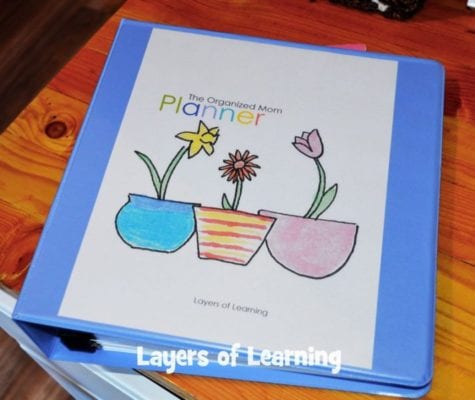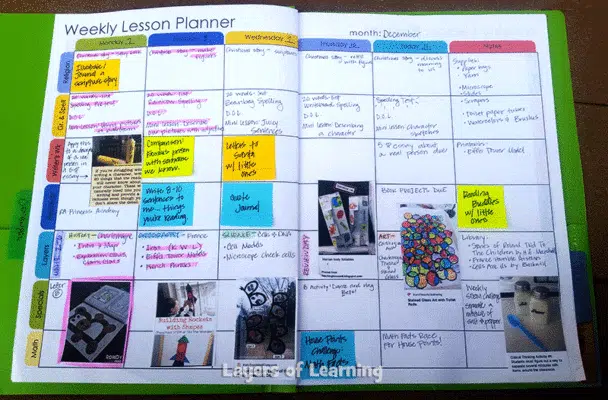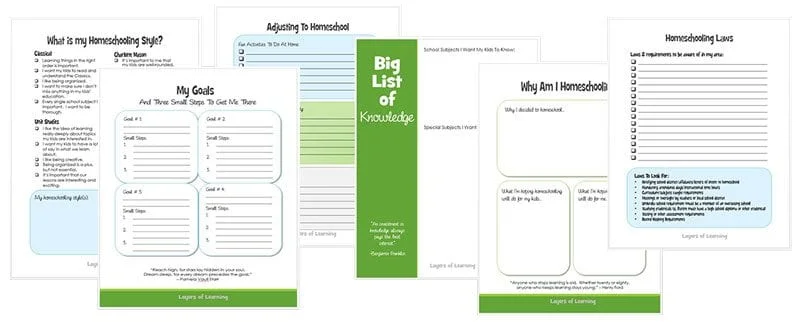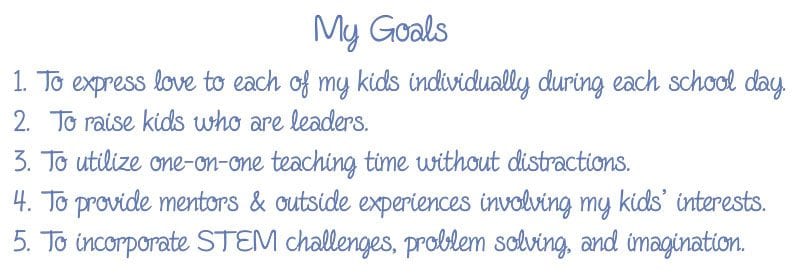Hopefully by now you’ve thought about your overall homeschool vision, decided what your homeschooling style is, and purchased your curriculum. {Did you feel as excited as I do when I open the boxes of shiny books?} Now it’s time to get right down to the business of planning out THIS YEAR in your homeschool.

Before you even begin a homeschool year, the very best gift you can give yourself (and your kids) is a plan. Whether you are hyper-organized or totally laid back, a basic homeschooling plan will make everything go more smoothly. My plan gives me overall inspiration, enthusiasm, and an I-can-tackle-it mentality, and also keeps me on track when my inspiration and enthusiasm wane. Read on to learn about how planning your homeschool year in advance will make all the difference. If you haven’t printed the How To Homeschool Guide For New Homeschoolers yet, grab that now. It has pages that will help you set goals and plan.
Set Goals
Goals must come first or else planning your homeschool year won’t have any real substance. My plan is all based around the goals I start with at the beginning of each homeschool year. My goals help direct everything we do. They are big picture goals, but because I have taken the time to write them down and really think about them, they infiltrate every one of our school days. They are specific and manageable, but not immediately accomplished. You’ll see that they are not necessarily the goals that a school teacher has; instead they are a fusion of my “mom goals” and “teacher goals.”
I’ll share with you an example – one of my goals is for my kids to be able to be comfortable in leadership positions in their lives. As a direct result, I have them:
- lead our morning meeting
- take turns preparing for and giving our daily devotionals
- stand in front of groups (our family, grandparents, etc.) and present projects
- create note cards for speeches and then learn those speeches well enough to reference, but not read from those note cards
- choose many of their own Layers of Learning explorations, writing assignments, and book projects
- lead discussions
- be responsible for filling out their own planner assignments and then checking them off as they complete them.
All of these things are daily items that are adding up to my overall goal. And I keep it all in mind as I’m planning my homeschool.
Determine A Schedule
When I sit down to plan my year, the very first thing I do is determine what kind of schedule we’re going to follow. Some people follow a public school calendar while some use a 4 school days a week plan. Some people take a week off every 6 weeks. It’s your school and your schedule.
As long as you are sticking with your state guidelines, you have a lot of flexibility. These are two of the most common schedules:
- 180 days of school, 5 days a week for a total of 36 weeks
- 180 days of school, 4 days a week, for a total of 45 weeks
Before each school year I plan out 40 weeks worth of work. You might use 36, 45, or some other number of weeks, but 40 is my magic number. Over years of homeschooling I’ve learned that I have 40 weeks in me and need the other 12 weeks in the year for breaks – rejuvenation time for both myself and my little ones. We take some of those in the summer and some interspersed throughout the year. You get to decide what works for you.
Your schedule will help you break down your curriculum to figure out your pace. If you use a program like Layers of Learning, you’ll be mapping out how many weeks to spend on each unit. You might be spending only one week on some units, or several on another. Your schedule will help you make your pacing guide.
Make A Pacing Guide
My pacing guide is my overall plan for my year. It is not dated. Life happens. I can’t plan when we’ll get the flu or I’ll be given extra responsibilities at my library board meeting. The pacing guide helps me stay on track, but still stay flexible. Remember this principle when you’re planning your homeschool year – make your plan work for you; you don’t work for it.
Our work is divided into two parts – written work and Layers of Learning.
Written Work
Written work is made up of our dailies – math, reading, and writing. Even when things get crazy, we get these basics done. Dailies don’t go in our pacing guide. I can’t know how long it will take a kiddo to master long division or write a five paragraph essay. Kids shouldn’t be moved along just because they are a certain age or a certain grade or because I planned a certain thing and they need to keep up. You can’t completely individualize instruction and also adhere to a pre-planned pace for daily work.
Layers of Learning & Specials
What my pacing guide is used for are our extra subjects and topics. Use the overall scope and sequence in the Layers of Learning Units At A Glance to plan. Look over the subjects for the year and decide which you want to spend a week, two, or three on. Specials are those electives that you chose. Remember, only include the ones you can realistically do this year. Don’t try to do it all.

I create my pacing guide so that I can:
- make sure I have the supplies on hand that I need, eliminating last minute stress
- quickly request the library books we’ll be using, expediting my planning time
- watch for ideas on Pinterest and from other homeschool moms and teachers I know, as well as any ideas that come to me in my own noggin.
- stay on track in the hustle and bustle of a busy school year when I may feel tempted to settle for less than my best.
After trying many things, this is the method that has served me best. The pacing guide supports me without stressing me out. I can stay on track, but not feel pressured by exact dates and deadlines.
Use An Undated Planner
My pacing guide is just an undated planner. The pages you see in the pictures are the 99¢ Layers of Learning Planner. It’s undated, printable, and you can use it year after year. It has lots of other cool pages and features too. Any undated planner will do though. I jot down which unit topics we are doing and any ideas I have to go with them. It starts out fairly blank, with mostly just topics, but fills up as the year goes on.
I write a lot directly on my planner, but I also use post-it notes if there are assignments with flexible timing. If we don’t get to something, I can just peel up the post-it and move it to another week. You’ll also see some printed pins from Pinterest in my planner. You’ll notice that in the final column, called “Notes,” I have my library list, supply list, and printables I need to print out.

Monthly Extras
As you’re planning your homeschool year, consider non-school commitments too. I look at holidays and plan some time for them. We need plenty of time for fun holiday art, poetry, writing, craft projects, cooking, and activities. I also make sure I leave enough room in there for an occasional week off in the middle of the year to recharge our batteries and some vacation weeks for family trips. Record ideas for holiday and extra family fun times on monthly pages since they are dated.
Reading Lists
At the beginning of every school year I also create reading lists. My kids mostly choose their own books each week when we go to the library, but there are a number of books that I consider greats that I don’t want them to miss. Each kids has their own reading list for the year in my plan. We also have a read aloud list – ideas for great books that I’d like to read them during the year.
Putting It All Together
Because I plan for 40 week school years, I use forty weeks worth of Pacing Guide pages. They have a spot for a date, but I don’t fill that in. I just fill in the units, explorations, expeditions, and other ideas I find. There is also a spot for our spelling words, vocabulary, and other sequential daily things. Mine always still has plenty of blanks that will get filled in as I find great ideas, but having the framework complete makes planning your homeschool feel manageable.
Once all these pages are together and filled up, I either 3-hole punch them and put them in a planning binder or have them bound at my local copy center with a spiral binding. They are part of my Layers of Learning Home and Homeschool Planner, and it’s all I need to keep myself and my family on track (and on time!).
Planning Your Homeschool Year For Peace of Mind
Once these things are all planned, I feel ready to start school. It gives me plenty of flexibility to change things up, but also allows me a framework to work from when things are hectic or my creativity is waning. I have yet to get through an entire year following everything I planned to the letter, but that’s not really the idea. My plan supports me; I don’t support it. It isn’t a to-do list that MUST be checked off, but rather a guide that gives me peace of mind.
Hopefully you can utilize a bit of what I’ve learned over many years of homeschooling. I promise, you will not regret taking time out for planning your homeschool year. If you have any great planning tips for me, I’d love to hear them!
Time To Start School
Now that your year is planned, it’s time to actually make the jump and start homeschooling. But you probably have lots of questions swimming around in your head right now.
- How do I cover everything?
- Can I teach things I don’t know?
- How do I homeschool when life is hard?
The next step will answer some of these.
Get a Free Unit
Choose between the first unit in each Layers of Learning subject to try for free when you sign up for the newsletter.
We never spam and you can cancel your subscription at any time.





Hi, I just discovered your curriculum & as I’m reading everything I can about it to make a decision, including this post about planning when I see MY activity (Building Rockets with Shapes) in your planner & that is just too cool! Hoped you liked it! And thanks for creating this awesome curriculum!
We loved that activity Samantha! What a fun connection! 🙂 Let us know if you have any questions about Layers of Learning…we’re always happy to help.
Gracias. Tengo todo el material reunido para el año, tengo las lecturas ya reunidas, el material de Arte y el escolar. Hoy la lectura sobre planificación me dio mucha tranquilidad. Gracias por todos tus consejos. Es lo que necesitaba.
¡Esperamos que su año escolar sea fantástico!
Es lo que necesitaba. Muchas gracias! Me he suscrito.
¡Eres muy bienvenido!